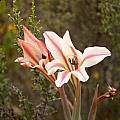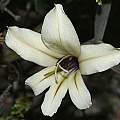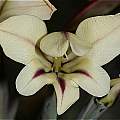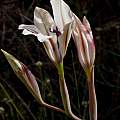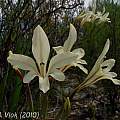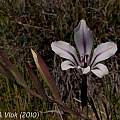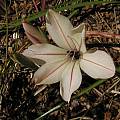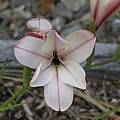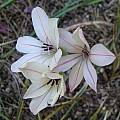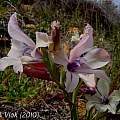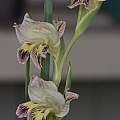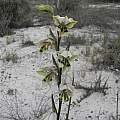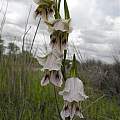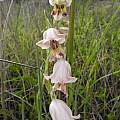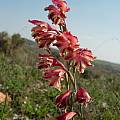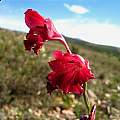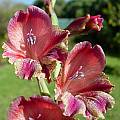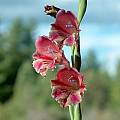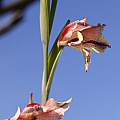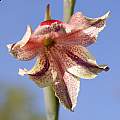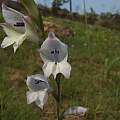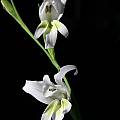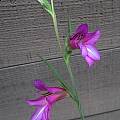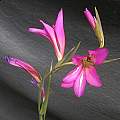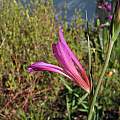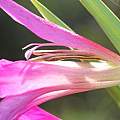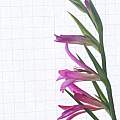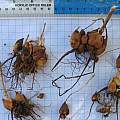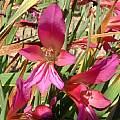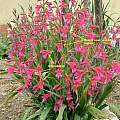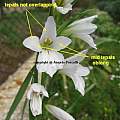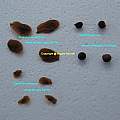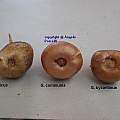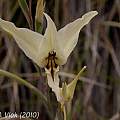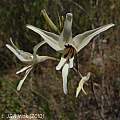These colors are often associated with moth pollination, and so some of the most fragrant Gladiolus can be found in this category. Another big group in this category are those species who have occasionally some kind of albino form - rare in nature, but eagerly adopted by gardeners when found.
Page 1: G. acuminatus... Page 3: G. longicollis... Page 4: G. parvulus... Page 5: G. sekukuniensis...
Gladiolus floribundus Jacq. grows on dry clay, sandy or limestone flats and slopes over a broad area of the winter rainfall Cape. It has white to cream or pinkish flowers with a dark median streak on all of the tepals and blooms in late spring. The first two photos taken by Cameron McMaster near Napier in the Overberg. Photos three, four, and five were taken by Andrew Harvie. Photo three was also taken in the Overberg in the De Hoop Nature Reserve. The last two were taken on a a rocky ridge top in the Swartberg Mountains.
Photos below from the book Plants of the Klein Karoo courtesy of Jan and Anne Lise Schutte-Vlok who write that this species grows up to 60 cm tall with broad grey green leaves. It can be confused with Gladiolus grandiflorus which has a shorter tube.
Gladiolus grandiflorus Andrews grows on clay slopes in the renosterveld in areas with winter rainfall and some year round rainfall. Growing from 25 to 50 cm, it has sword shaped leaves with thickened margins and midrib and cream to greenish flowers in a two to nine flowered spike, sometimes with a darker median streak on lower or all the tepals. If flowers September to October. Photos 1-3 by Mary Sue Ittner of plants grown from seed that had creamy white flowers marked in red and flowered late April, early May each year in her Northern California garden. Photo 4 taken by Bob Rutemoeller at Bontebok National Park September 2003. The last photo below from the book Plants of the Klein Karoo courtesy of Jan and Anne Lise Schutte-Vlok.
Gladiolus griseus Goldblatt & J.C.Manning grows in calcareous sand and limestone soils right near the sea, all up the southwest coast to Saldanha. The total wild population of this species is estimated to be less than 250 plants. There are 3 to usually 6 to 15 small mauve to grey flowers with a yellow band across the upper third of the lower tepals edged in green and maroon. The dorsal tepal arches over the stamens and the lower narrow tepals are directed forward. The flowers are lightly fragrant and bee pollinated. This species is closely related to Gladiolus carinatus and sometimes difficult to distinguish from it. Bloom time is different as this species blooms earlier in winter (May to July). The flowers are also smaller and unbranched with the upper tepals arched forward and there are usually more flowers on a spike. The first two photos from Arnold Trachtenberg. The last three photos taken June 2011 by Rachel Saunders on the southwest Coast shows the variation in different plants.
Gladiolus guthriei F.Bolus is a winter-growing species that occurs on rocky sandstone outcrops in the Western Cape. It incorporates plants formerly known as Gladiolus odoratus L.Bolus. It blooms in fall to early winter; April to June in its native range. Plants that will bloom send up a flowering stalk with very short leaf stubs on it. Plants not blooming in that year produce a long leathery leaf. The flowers generally have a pale yellow or straw base color, liberally decorated with mauve or dark magenta streaks and freckles. The result looks fairly dull from a distance, but the flowers reward close examination. They have a sweet scent. First four photos taken in Napier and Villiersdorp in the Overberg by Cameron McMaster. The fourth and fifth photos are of the Gladiolus odoratus form, blooming in December in California by Michael Mace.
Gladiolus inandensis Baker is a species that grows in small clumps to 20 to 45 cm. It is mostly found on sandstone soils in KwaZulu-Natal and the Eastern Cape, but it also has been recorded in Lesotho. Plants are found on rocky grassland and flower early in the summer rainfall region, mostly July to August, extending into September. This species has small white to cream flowers flushed with purple on the outside of the tepals. The dorsal tepal is hooded over the stamens. This species is unusual in that the flowers are usually produced before the new leaves on short stems with the dry dead previous foliage leaves attached to their base. This species is very similar to Gladiolus wilsonii but that species produces a stem after the new leaves are produced and flowers at a different time. Photo from Rachel Saunders.
Gladiolus involutus D.Delaroche is found on clay slopes in renosterveld and grassland in areas with summer and winter rainfall. Flowering from winter into spring, it has white flowers with yellow-green markings on the lower tepals. Photo by Bob Werra.
Gladiolus italicus has a broad distribution from southern Europe to parts of Asia growing on rocky hillsides, grassy areas, open forests and in fields. It flowers from March to July. Theophrastus wrote that the corm when pounded and mixed with flour made bread sweeter. It is distinguished from other European Gladiolus by having anthers that are longer than the filaments. Flowers are loosely arranged and facing various directions, pale pink as well as purple-pink to magenta with a pale blotch outlined in purple on the lower lobes. There are 5 to 15 flowers on the spike. Photos 1-2 taken by Mary Sue Ittner show the flowers of a plant grown from seed labeled G. italicus. Photo 3 was taken by Nhu Nguyen. Photos 4-6 by M. Gastil-Buhl include a close-up showing the relative length of anthers and stigma, a flower spike and corms still in the clusters as found when excavated against a 1 cm grid. The corms were found growing between 3 to 5 inches deep, including layers of added compost and grit. All of these corms and more grew in 2 years from just 4 juvenile corms.
Photos from Angelo Porcelli. The first is a close-up taken in habitat. The last three photos were taken from his article Gladiolus of Southern Italy. In this article he explains the difference between this species and Gladiolus byzantinus and Gladiolus communis. Gladiolus italicus is smaller, averaging 20 to 23 inches (50-60 cm) and has flowers with an "open" shape; the lateral tepals are oblong, narrow and well spaced, not overlapping the upper tepal and the two lower ones. Seed is quite different in this species from the other two which have winged seed. Seed looks like small pepper grains with three to four angles. Corms have a peculiar net on the tunics, especially on the top of the corm, and are a rather light brown color. This species is highly bulbilliferous and increases by cormlets at an alarming rate and a single corm will turn in a clump in a few years.
Gladiolus leptosiphon F. Bolus is an uncommon species from South Africa that occurs from Ladismith in the Little Karoo to Uitenhage in the Eastern Cape where it is found on stony hills and low mountain slopes in renosterveld or arid fynbos. It is threatened by ongoing habitat loss to agricultural expansion, particularly ostrich farming but also crop cultivation. Plants grow up to 60 cm tall with narrow whip like leaves and 6-9 creamy white flowers marked with dark red-purple lines on the lower three tepals and a long slender tube. The upper three tepals are largest, the dorsal suberect and the lower tepals narrow, channeled, arching downward. Flowering is in spring (October to November). Pollination is by a long-tongued fly. Photos from the book Plants of the Klein Karoo courtesy of Jan and Anne Lise Schutte-Vlok.
Page 1: G. acuminatus... Page 3: G. longicollis... Page 4: G. parvulus... Page 5: G. sekukuniensis...

